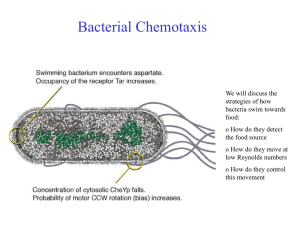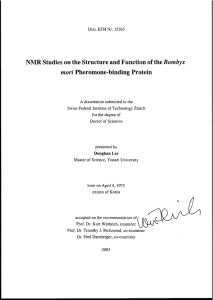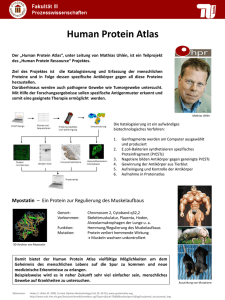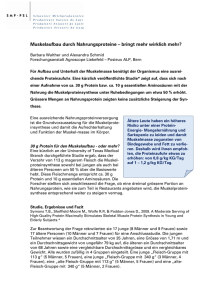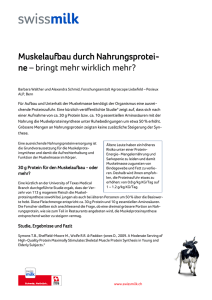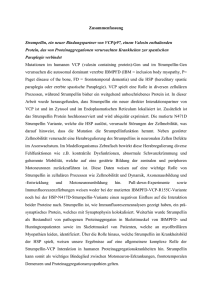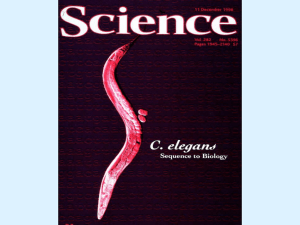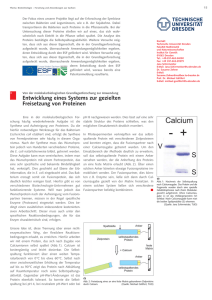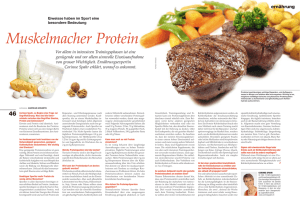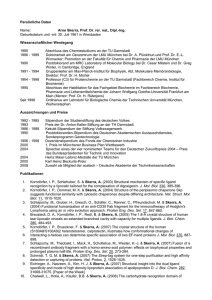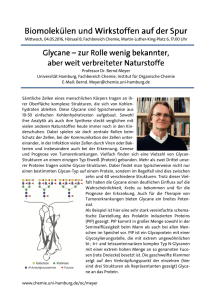Bacterial Chemotaxis
Werbung
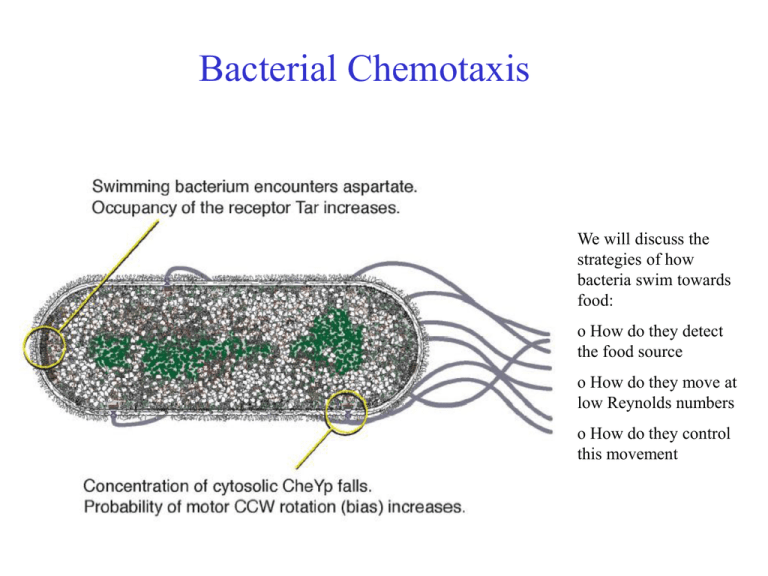
Bacterial Chemotaxis We will discuss the strategies of how bacteria swim towards food: o How do they detect the food source o How do they move at low Reynolds numbers o How do they control this movement Chemotaxis Definition : „The directed motion of organisms towards or away from chemical attractants or repellents.“ Chemotaxis of bacteria: Salmonella typhimurium are attracted by Serin (left) and repelled by Phenol (right) The amoeba Dictyostelium Discoideum runs towards increasing concentrations of cAMP. External Polymers in Bacteria Typically, two different External Polymers are found in Bacteria: o Bacteria can move with Pili by extending and retracting them inside the cell body (Type IV pilia). They are used to glue bacteria to each other to form biofilms, connect different bacteria for exchanging plasmids or let them attach to surfaces. o Flagella are used to swim. Often, Bacteria have several Flagella. Flagella Motor Bacteria swim with the help of Flagella (Geißel) which are rotated by transmembrane motors. A Flagella can rotate with up to 150 turns per second. Flagella Motor Movie http://video.google.com/videoplay?docid=-6630027279608718766 Bacteria move by rotating the Flagella At small scales, viscosity of water dominates and effects by inertia are absent. Thus swimming strategies are very much different from what we know at large scales. A good strategy is to swim by "drilling holes with a screw". Moving and Tumbling Bacteria Depending on the Rotation direction, several Flagella either form a bundle and allow forward simming or they "repell" each other and block swimming. The latter is due to inward propagation of interaction defects, given by the geometry of the flagella. Moving and Tumbling Bacteria From: Real-Time Imaging of Fluorescent Flagellar Filaments, LINDA TURNER, WILLIAM S. RYU, AND HOWARD C. BERG, JOURNAL OF BACTERIOLOGY, May 2000, p. 2793–2801 Strategie der Chemotaxis • • E. coli Bacteria have efficient molecular motors for locomotion They move by switching between direction runs and random tumble motions. Bakterielle Chemotaxis Die bakteriellen Geißeln sind in Bündeln angeordnet, welche die Eigenschaft haben, dass sie sich im Uhrzeigersinn (CW) drehen auseinanderstreben und sich zusammenlagern, wenn sie sich gegen den Uhrzeigersinn (CCW) drehen. Das Bakterium kennt daher zwei Bewegungszustände (A) geradeaus schwimmen (v=14-30m/sec, im Mittel 0.8s) und (B) taumeln. Im Mittel für 0.2s. Wird für das Bakterium die Konzentration eines Lockstoffes höher mit der Zeit, wird das Taumeln unterdrückt. Dadurch bewegt sich das Bakterium im Mittel in Richtung zunehmender Konzentrationen. Schwimm/Taumel (run & tumble) -Bewegung Die Bewegung von E.coli ist eine Folge von geradliniger Fortbewegung gefolgt von kurzen Umorientierungsphasen. Diese Schwimm&Taumel-Bewegung kann als Diffusionsprozess mit exponentiel verteilter Schrittlänge vt beschrieben werden. Man erhält die effektive Diffusionskonstante: v 2t DST 31 Laufgeschwindigkeit v, mittlerer Laufzeit t Richtungsfaktor . Richtungsfaktor beschreibt die mittlere Neuorientierung nach jeder Taumelphase =<cos>. Eine Gleichverteilung aller Richtungen (random walk) entspricht =0, keine Richtungsänderung =1. Mit v=30m/sec und t= 0,8sec, =0 erhält man DST=240 µm2/sec. Im Vergleich kleine Bio-Moleküle (Zucker, Peptide etc.) : D=400 µm2/sec !!! Mechanismus der mittleren chemotaktischen Drift Eine Erhöhung der Lockstoffkonzentration führt zu einer vorübergehenden Verlängerung der „Schwimmphase“. Dadurch wird der random walk ungleich gewichtet und es ergibt sich eine mittlere Driftgeschwindigkeit in Richtung höherer Lockstoffkonzentration. => Biased Random Walk Constraints: - only ~ 1,000 receptors - only 1 s to evaluate concentration Performance: - can detect < 1% change of occupancy - can operate over 5 orders of magnitude in ambient concentration Optical Methods: 3D Tracker Optical Methods: Optical Tweezer Ecoli in water.avi Tethering on Substrates Ecoli tethered.avi System Characteristics of the biological Network • Measurement of relative concentrations over time, not absolute concentration • Exact adaptation • Sensitivity by Amplification • Combination of signals from attractants and repellants. The range of concentrations which triggers chemotaxis ranges over 5 orders of magnitude (nM->mM) ! Input : ligand Attraktorkonzentration receptor complex kinase rotary motors Output : Taumelbewegung stimulus processing signal response Das intrazelluläre Signal-Netzwerk Aus genetischen Untersuchungen sind vier cytoplasmatische Proteine CheA, CheW, CheY und CheZ bekannt, die die chemotaktischen Rezeptoren mit dem Geißelmotor verbinden. CheW: Hilfsfaktor CheA : Proteinkinase CheY : Response Regulator CheZ : Phosphatase-activating Protein Reguliert durch den Rezeptor transferiert CheA eine Phosphorylierung auf das kleine CheY Protein. CheY-p diffundiert zu den Motorproteinen der Flagellen und induziert den Übergang des Motors in die Taumelbewegung. (CheY-p = Ein/Ausschalter) Das intrazelluläre Signal-Netzwerk Phosphorylation is the addition of a phosphate (PO4) group to a protein molecule or a small molecule. Reversible phosphorylation of proteins is an important regulatory mechanism. Enzymes called kinases (phosphorylation) and phosphatases (dephosphorylation) are involved in this process. Many enzymes are switched "on" or "off" by phosphorylation and dephosphorylation. Reversible phosphorylation results in a conformational change in the structure in many enzymes. For example, phosphorylation replaces neutral hydroxyl groups on serines, threonines or tyrosines with negatively charged phosphates with pKs near 1.2 and 6.5. Thus, near pH 6.5 they add 1.5 negative charges and above pH 7.5 they add 2 negative charges. It is estimated that 1/10th to 1/2 of proteins are phosphorylated (in some cellular state). A phosphorylated serine residue (from: http://en.wikipedia.org/wiki/Phosphorylation Das intrazelluläre Signal-Netzwerk CheR : Methyltransferase CheB : Methylesterase Die Rezeptoren werden mittels Methylierung sensitiver. Die Methylierung macht das Protein CheR, die desensitisierende Demethylierung das phosphorylierte CheB. Die Phosphorylierung von CheB wird von CheA getriggert. Damit ergibt sich an negativer Feedback-Loop. Werden Rezeptoren detektiert, wird über CheA und pCheB der Rezeptor weniger sensitiv. Methylation denotes the attachment or substitution of a methyl group on various substrates. Besides DNA methylation, typically at CpG sequence sites, Protein methylation typically takes place on arginine or lysine amino acid residues. Arginine can be methylated once or twice, Lysine can be methylated once, twice or three times. Protein methylation is one type of post-translational modification. From: http://en.wikipedia.org/wiki/Methylation Das intrazelluläre Signal-Netzwerk Phosphorylation is the addition of a phosphate (PO4) group to a protein molecule or a small molecule. Reversible phosphorylation of proteins is an important regulatory mechanism. Enzymes called kinases (phosphorylation) and phosphatases (dephosphorylation) are involved in this process. Many enzymes are switched "on" or "off" by phosphorylation and dephosphorylation. Reversible phosphorylation results in a conformational change in the structure in many enzymes. Die Zusammensetzung des Signalübertragungssystems Adaption Bakterien adaptieren ihre Signalantwort Beobachtung nach Zugabe des Lockstoffs bei t=0 : Die Taumelfrequenz (Häufigkeit einer Taumelbewegung pro Sek.) nimmt schlagartig ab. Nach einer gewissen Adaptionszeit t steigt die Frequenz wieder auf den alten Wertes an. Vorteil: Bakterium kann Veränderung der Lockstoffkonz. über einen enormen Größenbereich 10-10 M -10-3 M detektieren. unstimulated cells cells stimulated at time t =0 Systemantwort ist schnell <200ms, Adaption langsam (10 Minuten) Adaption durch Methylierung Methyl-akzeptierende Rezeptoren (MCP) Es gibt 8 Methylierungsstellen. Methylierung verringert die Rezeptoraktivität (wirkt wie Ligandbindung) E.coli kann Aspartat von 10-10 M-10-3 M (über 8 Größenordnungen) in der Konzentration nachspüren. Bakterien reagieren auf eine schnelle zeitliche Änderung des Lockstoffes nicht auf die absolute Konzentration Adaption unter Änderung der CheR Konzentration Die Adaptionspräzision ist unabhängig von CheR CheR wird mittels Plasmid unter externer Kontrolle eines Lac Operons von außen erhöht. Adaption unter Änderung der CheR Konzentration Die Adaptionspräzision ist unabhängig von CheR CheR wird mittels Plasmid unter externer Kontrolle eines Lac Operons von außen erhöht. Vergleich mit Systemkontrolle: Integral feedback control Doyl (1999) Der abgebildete Regelkreis verstärkt u in ein Ausgangssignal y. Dieses wird über den Integral feedback langsam auf Null zurückgeregelt (siehe Integralanteil bei PID Controllern). u: Eingangssignal (Lockstoffkonz.) x: Integral feedback (Grad der Methylierung) y0: Sollgröße y1-y0:Abweichung y: Ausgangsgröße (Rezeptoraktivität) Sensitivity of Motor Activation Das intrazelluläre Signal-Netzwerk Aus genetischen Untersuchungen sind vier cytoplasmatische Proteine CheA, CheW, CheY und CheZ bekannt, die die chemotaktischen Rezeptoren mit dem Geißelmotor verbinden. CheW: Hilfsfaktor CheA : Proteinkinase CheY : Response Regulator CheZ : Phosphatase-activating Protein Reguliert durch den Rezeptor transferiert CheA eine Phosphorylierung auf das kleine CheY Protein. CheY-p diffundiert zu den Motorproteinen der Flagellen und induziert den Übergang des Motors in die Taumelbewegung. (CheY-p = Ein/Ausschalter) Die Signalübertragunsfunktion ist sehr steil Hill koeffizient 10 Die Signalübertragunsfunktion ist sehr steil Hill Equation Binding a ligand to a receptor is often enhanced if there are already other ligands present (cooperative binding). The Hill coefficient, provides a way to quantify this effect, initially used for O2-binding to Hemoglobin. θ - fraction of ligand binding sites filled [L] - ligand concentration Kd - dissociation constant Hill koeffizient 10 Hill coefficient n. Describes the cooperativity of ligand binding: n > 1 - Positively cooperative reaction: Once one ligand molecule is bound to the enzyme, its affinity for other ligand molecules increases. n < 1 - Negatively cooperative reaction: Once one ligand molecule is bound to the enzyme, its affinity for other ligand molecules decreases. n = 1 - Noncooperative reaction: Independent binding to the receptor. Same as Langmuir equation. Messung der Motor-Signalübertragung Cluzel et al. Grün-fluoreszierendes Protein Die drei Aminosäuren Green fluorescent protein (GFP) From jellyfish Aequorea victoria bilden den GFP chromophore GFP kann gentechnisch mit anderen Proteinen fusioniert werden. Cluzel et al. haben CheY-P–GFP unter der Kontrolle eines Lac Promoters konstruiert. Fluoreszenz-korrelation erlaubt die Eichung der Proteinkonzentration in der Zelle Die Signalübertragunsfunktion ist steil Ein-Aus Schalter-Charakteristik, Verstärkungsfaktor 10 Gesamtverstärkung 60 (bei Front-end Verstärkung 3-5) Nur 0.1% Änderung der Rezeptorbesetzung Hill koeffizient 10 Collective Effects in Receptor-Field -> Slides from Talk of Tom Duke, Cavendish Laboratory, UK Signal processing by clusters of membrane receptors Tom Duke Ian Graham Cavendish Laboratory Dennis Bray Anatomy Department University of Cambridge Protein network unstimulated stimulated L M P CW CCW Protein network unstimulated stimulated adapted Exact adaptation Barkai & Leibler ‘97 If modification enzyme Che B binds only to active receptors, steady-state activity is independent of ambient concentration Robust, exact adaptation signal response concentration activity Exact adaptation Barkai & Leibler ‘97 If modification enzyme Che B binds only to active receptors, steady-state activity is independent of ambient concentration Robust, exact adaptation signal response concentration activity Separation of time scales: conformational transition ligand release phosphorylation methylation 10 -5 s ? 10 -3 s 10 -1 s 10 s response time adaptation time Protein network unstimulated stimulated adapted Step 1: Introduction of two conformation states of the receptor: active and inactive Step 2: Let these conformations couple to neighboring receptors Two-state ligand-binding protein inactive (-) active (+) ligand binds more strongly to inactive state unbound EA bound -EA Two-state ligand-binding protein inactive (-) active (+) ligand binds more strongly to inactive state unbound EA bound -EA mean activity depends on ligand concentration Chemical potential of bound ligand Probability of inactive state Parallel to binding, receptors become inactive (-): Fast way to some sort of 'adaption' behaviour - Simple model: thermodynamics Consider different receptors i with three states: si = li = i = -1 inactive +1 active 0 1 0 1 inactive active EM unbound unliganded liganded M energy M L unmodified modified bound L EL unmodified for the symmetric case the adapted system with P(si)=0.5 has L L M M modified Simple model: sensitivity to fractional change in concentration Sensitivity of adapted system change in ligand occupancy depends on shape of ligand-binding curve 1 0 4 EL 0.8 8 0.6 0.4 0.2 0 0.001 0.01 0.1 1 10 100 Concentration c/c c/K0.5 d 1000 Model: sensitivity to fractional change in concentration Sensitivity of adapted system change in ligand occupancy depends on shape of ligand-binding curve 1 0.8 0 EL 0.6 0 4 8 Sensitivity 4 8 0.4 0.2 0 0.001 0.01 0.1 1 10 100 Concentration c/c c/K 0.5 d 1000 Conformation-dependent coupling Shi & Duke ‘99 Receptors are clustered together energy reduced by J if neighbour in same conformation random field Ising model: possible phase transition at J = J* Conformational spread Ligand affects the receptor to which it is bound and, via conformational coupling, also influences other receptors in the immediate vicinity Realm of influence becomes very large close to the phase transition correlation length enhancement Response to doubling of concentration Duke & Bray ‘99 System responds sensitively over a wide range of ambient concentrations: 100 initial 10 100 1 0.1 0.01 % change in signal Activity 1 coupled receptors 10 1 uncoupled receptors 0 -5 0 5 Time (s) 10 0.001 0.01 0.1 1 10 Concentration c/c c/K0.5 d 100 1000 Mixed receptor clusters aspartate serine ribose peptides galactose T Ni2+ Tsr Tar Trg Tap Two-state protein binding different ligands Exclusive binding of two different ligands L and M EA EL response ~ L OR M EM p- L M Two-state protein binding different ligands Exclusive binding of two different ligands L and M EA EL response ~ L OR M EM p- L switch sharpened by cooperativity in a cluster M Two-state ligand-binding protein Exclusive binding of two different ligands L and M EA EL EM EM is positive, no stabilization of inactive bound state response ~ L AND NOT M p- nutrient L • eg. extend run IF increasing amount of nutrient AND NOT toxin toxin M Two-state ligand-binding protein Non-exclusive binding of two different ligands L and M L AND NOT M OR OR EA EL EM ELM ELM AND AND M AND NOT L (L AND NOT M) Introducing neighborhood of two receptors allows to introduce ELM parameter depending on the combined state. As result, logical gates are possible. Receptor trimers as logic elements Cluster is an extended array of trimers of receptors mixing different receptors in each trimer group provides a variety of basic logical elements The logical repertoire of ligand-binding proteins Ian Graham and Thomas Duke, 2005 Phys. Biol. 2 159-165 doi:10.1088/1478-3975/2/3/003 Abstract. Proteins whose conformation can be altered by the equilibrium binding of a regulatory ligand are one of the main building blocks of signal-processing networks in cells. Typically, such proteins switch between an 'inactive' and an 'active' state, as the concentration of the regulator varies. We investigate the properties of proteins that can bind two different ligands and show that these proteins can individually act as logical elements: their 'output', quantified by their average level of activity, depends on the two 'inputs', the concentrations of both regulators. In the case where the two ligands can bind simultaneously, we show that all of the elementary logical functions can be implemented by appropriate tuning of the ligand-binding energies. If the ligands bind exclusively, the logical repertoire is more limited. When such proteins cluster together, cooperative interactions can greatly enhance the sharpness of the response. Protein clusters can therefore act as digital logical elements whose activity can be abruptly switched from fully inactive to fully active, as the concentrations of the regulators pass threshold values. We discuss a particular instance in which this type of protein logic appears to be used in signal transduction—the chemotaxis receptors of E. coli. Summary Receptor cluster is a sophisticated analog computer adaptation (exact) differentiation of signal clustering (maybe tunable) sensitivity over wide range coupling of different receptors logical responses to combined stimuli Verhalten sich Signal-Netzwerke wie neuronale Netze, welche durch Evolution geschult wurden? Bray 1991 Zusammenfassung • Diffusion ist eine Zufallsbewegung, die auf mikroskopischen Längen eine schnelle Verteilung von Stoffen ermöglicht, auf makroskopischen Skalen aber als Transportmechanismus versagt. • E.coli kann Gradienten über einen künstlichen Suchmechanismus und einen Vergleich der Konzentrationen über die Zeit detektieren. • Systembiologie (computational systems biology) entwickelt quantitative Modelle komplexer biologischer Organismen zur Vorhersage von Systemantworten auf äußere Reize.
